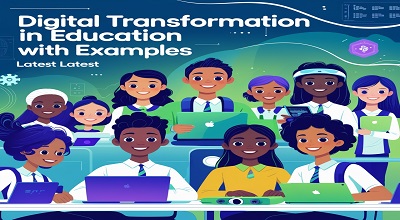Digital Transformation in Education
Digital Transformation in Education: The education sector is undergoing a massive shift due to digital transformation. With advancements in technology, traditional classrooms are evolving into smart, interactive, and globally connected learning environments. This article explores the latest trends, technologies, and real-world examples of digital transformation in education.
From AI-powered learning platforms to virtual reality classrooms, digital transformation is reshaping how students learn, teachers instruct, and institutions operate. Let’s dive deep into this revolution.
What is Digital Transformation in Education?
Digital transformation in education refers to the integration of digital technologies into all aspects of teaching, learning, and administration to enhance efficiency, accessibility, and engagement.
Key Aspects Include:
- Online Learning Platforms (LMS like Moodle, Blackboard)
- AI & Machine Learning (Personalized learning, chatbots)
- Virtual & Augmented Reality (Immersive learning experiences)
- Big Data & Analytics (Tracking student performance)
- Cloud Computing (Remote access to resources)
- Blockchain (Secure credentialing and certifications)
This transformation is not just about using digital tools but rethinking the entire educational ecosystem for better outcomes.
Key Drivers of Digital Transformation in Education
A. Rising Demand for Remote Learning
The COVID-19 pandemic accelerated the adoption of online learning, making digital education a necessity rather than an option.
B. Personalized Learning Needs
Students now expect tailored learning experiences, which AI and adaptive learning technologies can provide.
C. Government Initiatives & Funding
Many governments are investing in EdTech to modernize education systems (e.g., India’s Digital India campaign).
D. Technological Advancements
Innovations like 5G, AI, VR, and IoT are making digital education more interactive and accessible.
E. Industry 4.0 & Workforce Skills
Schools and universities are aligning curricula with digital skills needed for future jobs.
Technologies Powering Digital Transformation in Education
A. Artificial Intelligence (AI) & Machine Learning
- Chatbots (e.g., Georgia Tech’s AI teaching assistant “Jill Watson”)
- Automated Grading Systems (e.g., Gradescope)
- Adaptive Learning Platforms (e.g., DreamBox, Knewton)
B. Virtual Reality (VR) & Augmented Reality (AR)
- Medical Training (e.g., VR surgeries at Stanford University)
- Virtual Field Trips (e.g., Google Expeditions)
C. Learning Management Systems (LMS)
- Moodle, Canvas, Blackboard – Centralized platforms for course management.
D. Blockchain for Education
- Secure Diplomas & Certificates (e.g., MIT’s blockchain-based digital diplomas)
E. Cloud Computing & Big Data
- Google Classroom, Microsoft Teams – Cloud-based collaboration tools.
- Predictive Analytics – Identifying at-risk students early.
Benefits of Digital Transformation in Education
A. Enhanced Accessibility
- Remote learning for rural and disabled students.
B. Personalized Learning
- AI tailors content to individual student needs.
C. Cost Efficiency
- Reduced infrastructure costs with online classes.
D. Improved Engagement
- Gamification and interactive content boost participation.
E. Data-Driven Decision Making
- Analytics help educators refine teaching strategies.
Challenges and Solutions
A. Digital Divide
- Challenge: Not all students have access to devices/internet.
- Solution: Government subsidies, offline learning tools.
B. Cybersecurity Risks
- Challenge: Data breaches in online platforms.
- Solution: Strong encryption, blockchain security.
C. Resistance to Change
- Challenge: Teachers reluctant to adopt new tech.
- Solution: Training programs, incentives.
D. Content Quality Control
- Challenge: Misinformation in digital resources.
- Solution: AI-powered content verification.
Latest Examples of Digital Transformation in Education
A. BYJU’S (India)
- AI-driven personalized learning app with over 150 million users.
B. Duolingo (Global)
- Gamified language learning with AI tutors.
C. Coursera & edX
- Partnerships with top universities for online degrees.
D. Labster (Denmark)
- Virtual science labs for students worldwide.
E. AltSchool (USA)
- AI-powered micro-schools with personalized curricula.
Future Trends in Digital Education
A. Metaverse Classrooms
- Virtual campuses where students interact in 3D spaces.
B. AI-Powered Lifelong Learning
- Continuous upskilling with AI mentors.
C. Neuroeducation
- Brain-computer interfaces for optimized learning.
D. Blockchain Degrees
- Tamper-proof digital credentials.
E. Hybrid Learning Models
- Blending online and in-person education seamlessly.
Conclusion
Digital transformation in education is no longer optional—it’s essential. Institutions that embrace AI, VR, blockchain, and cloud computing will lead the future of learning. While challenges like the digital divide persist, innovative solutions are emerging.
The latest examples show how technology is making education more inclusive, engaging, and efficient. The future promises even more exciting advancements, from metaverse classrooms to AI-driven lifelong learning.
FAQs
Q1: What is digital transformation in education?
Digital transformation in education involves integrating digital technologies (AI, VR, LMS) to enhance teaching, learning, and administration.
Q2: How does AI help in education?
AI enables personalized learning, automated grading, and chatbots for student support.
Q3: What are the risks of digital education?
Cybersecurity threats, digital divide, and misinformation are key risks.
Q4: Which countries lead in digital education?
USA, China, India, and Nordic countries are at the forefront.
Q5: Will digital education replace traditional schools?
No, but hybrid models (online + offline) will dominate the future.
Free Here: Brawl Stars APK
